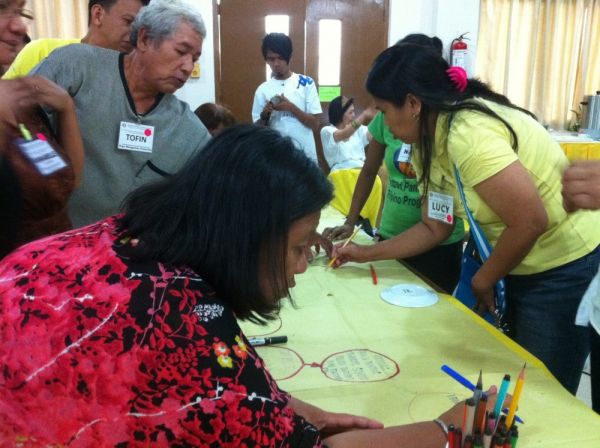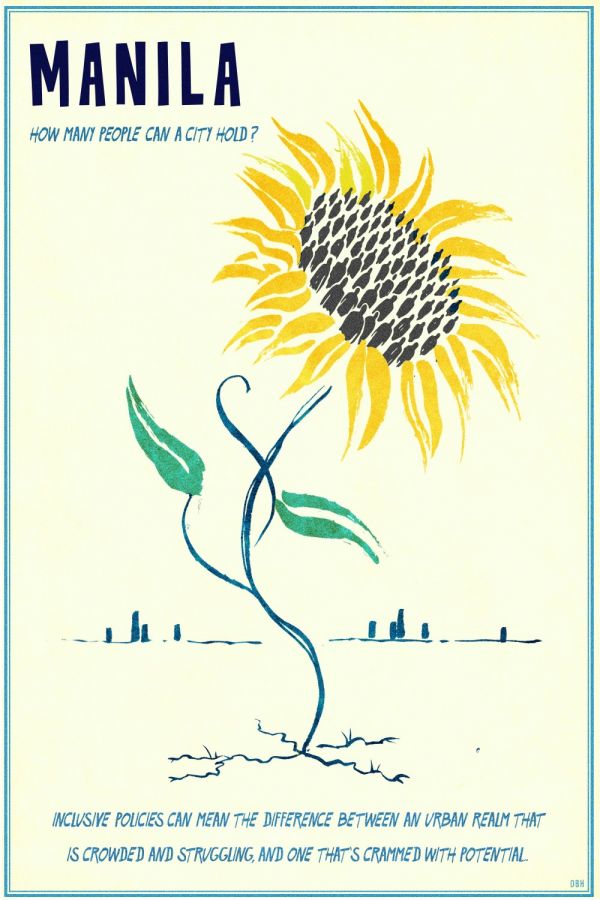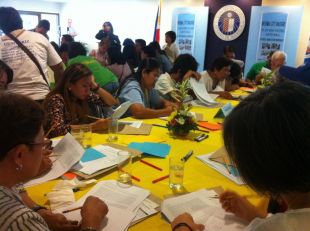Can Manila Outrun Its Population Growth With Smart Urban Planning?

Participants in Manila’s future scenarios workshop. Photo credit: Purple Romero
As the Informal City Dialogues moves toward its “Embracing the Informal City” conference this month, each week we will present summaries of the scenarios created in the six participating cities. These scenarios were created in multi-day workshops planned and conducted by Forum for the Future in conjunction with the Ateneo School of Government, and with support from The Rockefeller Foundation. The outputs were collaboratively envisioned by a wide range of actors, from informal settlers and street vendors to urban planners and government officials. The following is an excerpt from Forum for the Future’s report on the scenarios developed in each city, which will be published this month. Click here to read more about how the futures scenarios process works.

Illustration by Daniel Horowitz
Manila
The future of Metro Manila will be primarily determined by two forces: The rate of population growth, and the effectiveness of urban planning and development. Slower population growth in combination with effective urban planning and development will lead to a city that works for everyone, with enough food, jobs and housing for all. That same effective planning can even mitigate the problems of fast population growth — renewable energy, smart transit and affordable housing keep the ballooning city livable. It’s when planning becomes ineffective that problems begin to arise. A slow-growing Manila that’s poorly planned will stagnate, suffering from labor shortages and widespread malaise. A fast-growing Manila that’s poorly planned is even worse, marked by frequent food shortages, unemployment, flooding and expensive education.
Kanlungan (Shelter)
Slow population growth and effective urban planning have enabled Manila to become prosperous, healthy, and inclusive by 2040. Progressive reforms initiated in the 2010s, including the Reproductive Health Act and a program to provide cash to indigent families for child education and maternal health, have been continued by subsequent administrations. The Farm to Market program has curtailed food insecurity. Public housing has put an end to evictions and resettlement and the few remaining informal settlers are all living in medium-rise buildings (MRBs). New housing developments are built sustainably and communities are more walkable, energy efficient, and livable. Unemployment is low, meaning that workers remain in the Philippines and families are kept together. Affordable and high-quality healthcare and education are widely available. Pollution has been largely eliminated and technological innovations have been developed to mitigate the risk of other natural hazards like earthquakes. The well-educated populace is politically engaged, ushering in an era of better governance.
Hawak Kamay (Holding Hands)
In this version of Manila’s future, the challenges of rapid population growth are met through collaboration and effective urban planning. By 2040, Manila’s population has expanded significantly—but slums have disappeared, there is ample public housing, and people are happy living in smaller spaces. Housing is generally affordable, accessible, and safe, and nearly everyone has security of tenure. Pedestrian areas and green space are both abundant and public transit is widespread, accessible, and efficient. The city has been re-designed with disaster risk reduction and climate resiliency as priorities—so that when disasters do occur, they are no longer catastrophic. All children have access to education. Solar energy provides for most of the country’s energy needs

Participants in Manila’s innovation workshop. Photo credit: Purple Romero
Maghintay ka lamang (Just Wait)
In this scenario, slow population growth and ineffective urban planning have engendered widespread apathy among the people of Manila by 2040. Successful implementation of the reproductive health law has slowed down population growth but other aspects of governance and planning have been less effective, however. Manila these days feels like it did in the more “laid back” 1960s—less chaotic but also stagnant. The government tried to address the housing issue in the 2010s by constructing MRBs and relocating settlers. But by failing to do so in a truly consultative way, and ignoring key issues like the prohibitively high cost of transportation, this initiative ultimately failed and slums have proliferated. A labor shortage is compelling many of the elderly and the young to work, often in the informal sector, preventing children from going to school. Climate change has disrupted weather patterns and Manila is now subject to droughts, rather than typhoons and flooding. Increased temperatures coupled with a lack of potable water are causing disease. People accept these problems with resignation and focus on meeting their immediate needs.
Run Samson Run
In this scenario Manila is hobbled by the negative effects of rapid population growth coupled with ineffective urban planning. By 2040, the population has exploded and many people are unemployed. Environmental degradation is widespread, the supply of water and energy from public utilities is inadequate, and the number and quality of public spaces is declining. Development is mostly unplanned and uncontrolled. Hunger, unemployment, prostitution, and crime are all on the increase. Foreign investment and tourism have declined over the intervening decades causing job losses and a drop in revenue. Poverty is endemic and there is a generalized lack of access to government services. Agricultural land around Manila has been developed for other uses, leaving the city dependent on food procured from much further away in the country—a situation that is more expensive and less reliable. Education is too expensive for many families to afford. Informal settlements are common and many of them exist in hazardous areas. Regular flooding has caused widespread loss of life and billions of dollars in damages.









